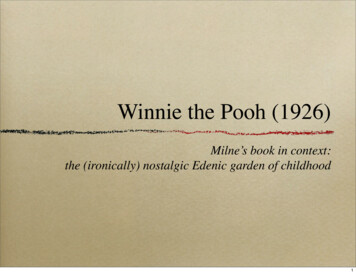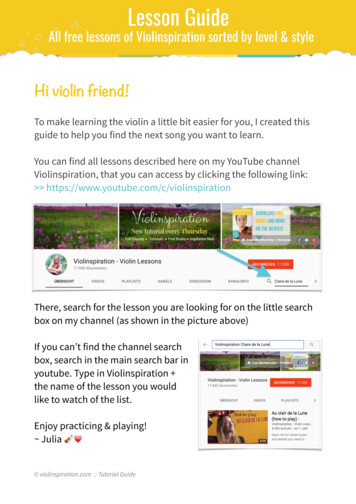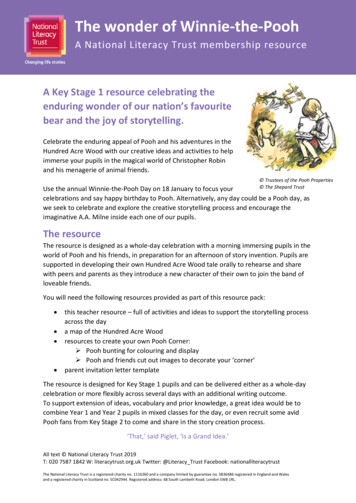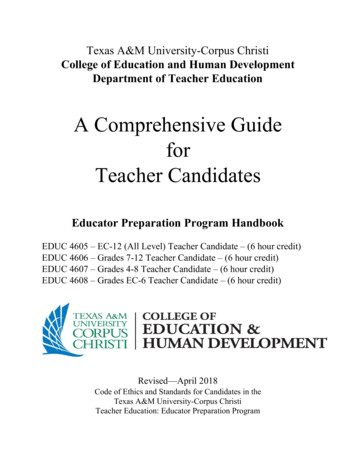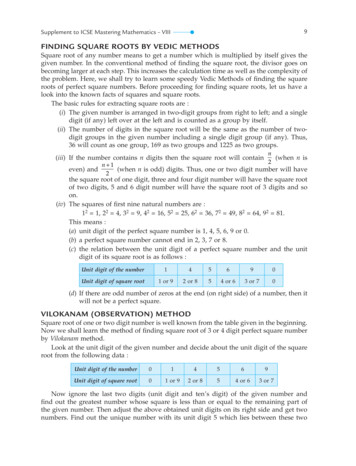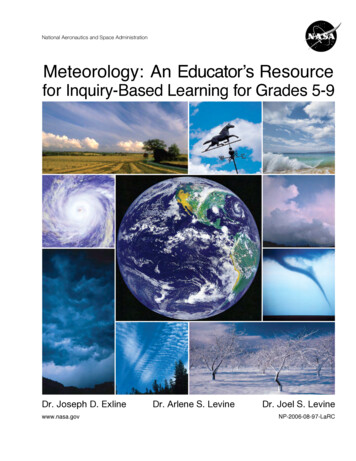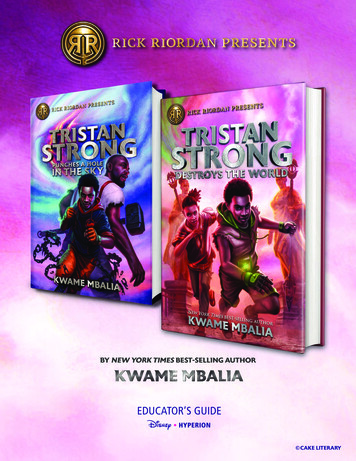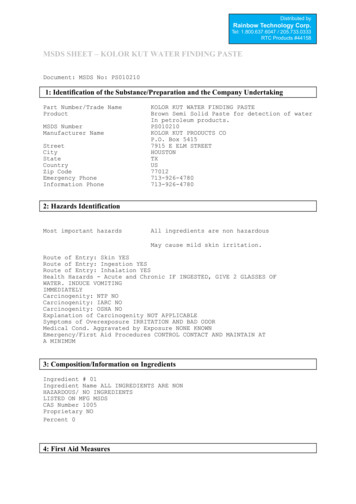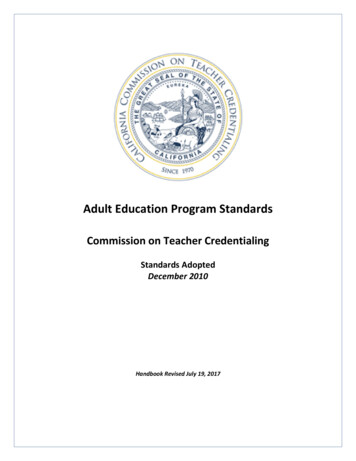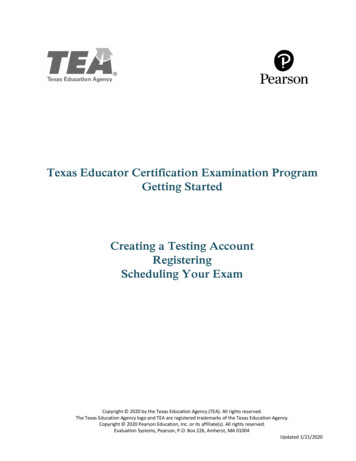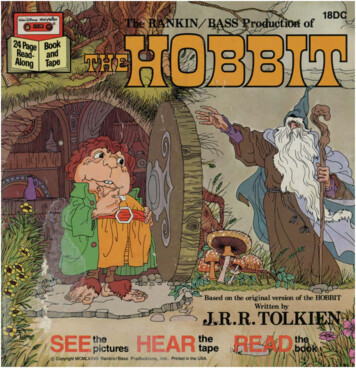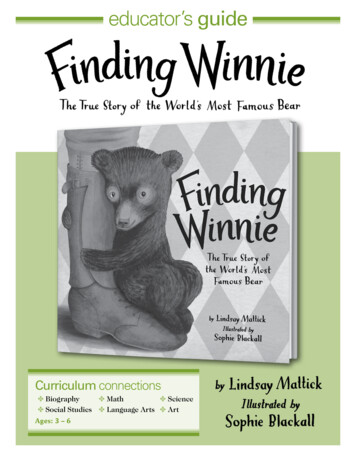
Transcription
educator’s guideCurriculum connectionsD BiographyD MathD ScienceD Social Studies D Language Arts D ArtAges: 3 – 6
Dear Teachers,Finding Winnie is one of those special books that holds appeal and depth across ages.Preschool and primary grade students will ‘ooh and ahh’ over Winnie as an adorablebear cub, find humor in her antics while she is embedded in Harry’s regiment, andmarvel that children just like them were allowed to romp with Winnie in her enclosureat the London Zoo. At this age, they will delight in making the connection to the “sillyold bear” they know from stories and screens and will find reassurance in the familiarcloseness of the bedtime tale told by mother to child.Students in the intermediate grades will also find the storybook character connectionsengaging and will have a strong appreciation for a story well told and well retold. Theywill be fascinated by the concept of a bear on the battlefield and intrigued by HarryColebourne’s role as veterinarian. At this age, they are ready to grapple with the ideaof animals and humans on the battlefield. Their emerging sense of morality and theirdeveloping emotions will allow them to relate strongly to Harry’s attachment to Winnieand to weigh the decisions that he must make about her well-being.Middle and high school students will be able to discuss and ponder the deeper themesthat emerge from this compelling story. They will consider the relationship of loveand care-taking, the pain and joy of separation and togetherness, and the way thatstories forge connections across generations. They may be able to begin to articulate anunderstanding that in the most horrific of circumstances, in this case war, people findways to express their humanity. Students of this age will begin to see themselves, likeHarry, Winnie, Christopher Robin, and Cole, as caretakers of the people and animalsthey encounter in their everyday lives.Adults and children alike will find much to learn from Mattick’s use of languageand in the artistry of Blackall’s visual storytelling. Such rich matter for discussion,such rich opportunity for learning across content areas! The activities included hereillustrate some possibilities for this book in the classroom when studying writing, visualdesign, book characters, life 100 years ago, World War I, ancestry, or animal-humanrelationships. We know you will find youself, your students, and your curriculumenriched by Finding Winnie.Yes, there’s something very special about this book!2
SOCIAL STUDIESbe best for Winnie? Was this sometimes differentthan what he wished for? Connect this discussionto the phrase repeated in the book: “His heartmade up his mind.” Extend this activity by invitingstudents to tell a story or to write about a timewhen they engaged in a caregiving activity.Family StoriesAuthor Lindsay Mattick chose to tell the story ofher great grandfather in the format of a bedtimetale to her son. Invite your students to rememberfamily stories that they have been told. Modelthis process by sharing a family story of your own,describing who first told you the story, where andwhen the story was told and the story itself. Youmay want to have children talk with their families/caregivers about the special stories that help themto know and understand their family history.Invite students to share some of these stories withtheir classmates, either orally or through writingand illustration. You may also consider invitingparents/caregivers in to the classroom to sharethese stories, possibly recording them as podcasts.The recorded stories on National Public Radio’sStory Corps website (storycorps.org) can serve asinspiration for this project.Family TreeThe last pages of Finding Winnie include a familytree; illustrator Sophie Blackall has provided readerswith an image that supports understanding of thefamily relationships described in the narrative.This particular family tree depicts direct lineageonly. Provide students with other examples offamily trees, either found in children’s literatureselections or elsewhere. What kinds of informationare included in family tree representations? Howare relationships represented graphically? Whatvariations do they notice? Collaborate with an artspecialist to provide students with the opportunityto create an illustrated family tree that reflectsmeaningful relationships in their lives (these neednot be blood relatives). Share students’ artworkwith family members through a classroom museumdisplay with an open house or via technology.“Raising” Winnie:The Concept of CaregivingAs he listens to his mother describe the momentwhen Harry met Winnie, Cole asks his mother toexplain what she means when she says, “Trappersdon’t raise bears.” Her response reflects a keyconcept in the book, that of caregiving. Ask yourstudents to consider what it means to ‘take care’of an animal or another person. Younger studentscan provide an oral response or draw a picture —besure to document their responses on a chart, in aclass-created book, or with a visual display. Engagestudents in a deeper discussion of Harry’s actionsin the book. At which junctures in the story didHarry make decisions that would impact Winnie’sfuture? What examples of caretaking are providedin the book? How did Harry decide what wouldWhat is a Veterinarian?Harry Colebourne is described as an exceptionalveterinarian, one who had a special affinity withand devotion to animals and whose “hands werenever cold.” Students may be familiar with theconcept of a ‘vet’ who takes care of householdpets like cats and dogs, but may be surprisedto learn that the job can involve more. Explorestudents’ understandings of this occupationby asking them to describe what a veterinariandoes. Extend their understanding by inviting aveterinarian to speak to your class either in personor via videoconference. Prior to the visit, work3
with students to develop a list of questions thatthey will pose. Students can take notes about theveterinarian’s responses. If you have time, ideallyyou would also have students interview a secondveterinarian whose job is very different from thefirst due to the types of animals he/she primarilyworks with or the context in which he/she works.The interview data can be supplemented withnonfiction books or digital resources that presentthe varied roles that can be played by veterinariansand the different settings in which they maywork. Students can develop a presentation thatshowcases their new understandings of thisimportant job.Students can make notes about new informationthat they learn while exploring these resources.You can also read Sally Walker’s Winnie: The TrueStory of the Bear Who Inspired Winnie-the-Pooh(illustrated by Jonathan D. Voss). A comparisonof Winnie’s story across these two books offersan excellent opportunity to discuss the choicesthat authors make when writing. Comparing thecontent and writing style of these two books willlead to conversations about an author’s researchprocess, his/her choices about which content toinclude in a story and which to exclude, whichaspects to emphasize, and how to use languageto inspire a particular response from a reader, andfinally, when to stick to the facts and when to inferand/or fictionalize.More About WinnieTo learn more about Winnie while learning moreabout the processes of research and writing,supplement Finding Winnie with primary sourcedocuments and additional texts, creating a text setfor students to explore. Ryerson University Libraryand Archive has an interactive online exhibit, TheReal Winnie (therealwinnie.ryerson.ca), developedin collaboration with Harry Colebourne’s family,that includes photographs, images of diary pages,essays, maps, and even a 3D vet kit. Other onlineresources to explore include:Animals in WWIWinnie’s role in World War I was to serve as amascot for Harry Colebourne’s Infantry unit. WhileWinnie was sent out of harm’s way, this was notthe case for other animals, including the horsesunder Harry’s care. Older students can learn moreabout the varied roles played by animals in WorldWar I. A good starting place for this research inThe Atlantic’s online photo essay “World War I inPhotos: Animals at War”: theatlantic.com/static/infocus/wwi/wwianimals. You will want to previewthis resource because it includes some graphicimages.White River Heritage Museum: The History ofWinnie the Pooh whiteriver.ca/article/winnie-thepooh-6.aspStudents can also learn more about animals andWorld War I in Mark Greenwood’s Midnight:A True Story of Loyalty in World War I (illustratedby Frané Lessac), The Donkey of Gallipoli: A TrueStory of Courage in World War I (illustrated by FranéLessac), or Ann Bausam’s Stubby the War Dog: TheTrue Story of World War I’s Bravest Dog. Movingbeyond World War I, students can read aboutThe Fort Garry Horse Museum and Archives:Lt. Harry Colebourn and ption comcontent&view article&id 51&Itemid 59The London Zoo: The Bear Who Inspired Winniethe-Pooh ed-winnie-the-pooh4
another bear on the font lines in Bibi Dumon Tak’sSoldier Bear. Next, have students consider the rolesthat animals play in today’s military consultingbooks such as Dorothy Hinshaw Patent’s Dogs onDuty: Soldiers’ Best Friends on the Battlefield andBeyond or the following online resources:miles that Winnie traveled. Have students createa visual map/timeline that includes each of theselocations. Students should include illustrations thatdepict key events for Winnie at each location andthe dates and distances of her travels.What Did it Cost 100 Years Ago?US Navy: Marine Mammal Program .aspxCole asks his mother, “Is 20 dollars a lot?” Use thisquestion as a launching point for an investigationof the rate of inflation over the course of a century.Ask students to brainstorm a list of commonlypurchased items and research what these itemswould have cost when purchased in 1914. Recruitthe support of your town historian who may beable to visit and share documentation/artifactsthat provide information on the cost of daily lifein 1914. Students can create an infographic thatputs the cost of Winnie in perspective with othercosts in 1914 and with those same expenses in2014. While it is important to note that Harrywas spending Canadian rather than U.S. dollars,a discussion of the exchange rate may only berelevant for older students.Smithsonian Institute: How Did Animals (EvenSlugs) Serve in World War I lugs-serve-world-war-iMATHMapping Winnie’s JourneyRevisit the pages in Finding Winnie that depictWinnie’s travels by rail, ship, and car. Havestudents list the names of the locations to whichWinnie traveled. Using an online mapping toolwith satellite imagery (such as Google Earth),follow Winnie’s journey so that students get asense of the great distance that she traveled fromthe forest that was originally her home. Add up the5
LANGUAGE ARTSdigital technologies as modern day scrapbookingtools. Begin a class scrapbook to preserve classroommemories; students can take turns working inteams to document special events with imagesand writing.Book BearsBear characters have played a prominent role inchildren’s literature, with characteristics rangingfrom scary to silly to serious. Consider as examples:Paddington, Corduroy, Goldilocks’s three bears,Baloo, Br’er Bear, Little Bear, and more moderncounterparts. Ask your students to brainstorm alist of children’s books that feature bears. Extendtheir listing of bears with others so that you canassign different bear characters to pairs of students,providing the partners with the book that featurestheir character. Ask each pair to prepare a briefdramatic skit to present the bear character to theirclassmates. The skit should demonstrate essentialcharacteristics of the literary bear, a brief plotsummary, and a discussion of how the bear species isrepresented through the narrative. Is their characterbear more like a bear or more like a human?Storytelling Exercise: A Favorite AnimalLindsay Mattick has chosen to tell the story of hergreat grandfather and Winnie the bear in the formof a bedtime story. This structure provides andexcellent opportunity to explore both narrativestructure and the art of storytelling. Ask yourstudents ‘What makes a good story?’ and recordtheir responses. Use the criteria they have set toevaluate the story in Finding Winnie; as you reviewthe story it is likely that you can tease out newcriteria to add to their listing. In this story, theauthor has chosen to incorporate a conversationbetween the storyteller (the narrator) and thelistener into the overall narrative; talk aboutthe effect of this authorial choice and exploreadditional picture books that use this technique,such as The Chalk Doll (written by CharlottePomerantz and illustrated by Frane Lessac) or TheBear in the Book (written and illustrated by KateBanks). Following this exploration of storytellingtechniques, invite your students to write and tellorally a story about a favorite animal (or leavethe subject matter more open-ended). You mayalso find useful the following online resources onstorytelling:ScrapbookingHow do we preserve physical artifacts associatedwith family stories and special moments? The backmatter of Finding Winnie has been designed tolook like the album that young Cole and Lindseyare looking at together at the end of the story.Study this section of the book with your students.What kinds of items are found here? How/whyare these items important and meaningful to thestory of Harry Colebourne, Winnie, and Harry’sfamily? How are these items organized? How dothey appear to be physically affixed to the page?Invite children to bring in any scrapbooks thatthey keep at home. Talk about the memories thatare preserved in these albums. Consider inviting ascrapbooking expert from a local craft store intothe classroom to discuss materials and strategiesthat can be used. You may also want to exploreNCTE: Read Write Think: Qualities of GoodStorytelling torytellingR.pdfNCTE: Guideline on Teaching storytellingInternational Storytelling Center: Learning brary6
The Story Behind the StoryDialogue: Conversation in StoryAfter reading Finding Winnie, read aloud theintroduction and the first chapter of Winniethe-Pooh by A.A. Milne. What connections canstudents make between these two very differentstories? After this comparison, consider howWinnie the bear has both inspired A.A.Milne’sstories and retellings of these stories and how herown story has been retold in text and film. Showstudents clips of Disney’s version of Winnie-thePooh as well as clips of the television movie ABear Called Winnie. Share Sally Walker’s versionof Winnie’s story in Winnie: The True Story of theBear Who Inspired Winnie-the-Pooh (illustratedby Jonathan D. Voss). Consider these questions:Where do stories come from? Why are storiesretold? What happens when stories are retold orre-envisioned in a different media?Throughout Finding Winnie, Cole interrupts hismother’s story with questions. The conversationsbetween Cole and his mother appear in italicizedfont and offer an opportunity to look closelyat the conventions of dialogue in story. Projectthese conversational exchanges so that studentscan study them to infer guidelines for the use ofpunctuation and options in the use of dialoguetags. After students have generated a list ofguidelines, test out their listing by examiningsamples of dialogue as it appears in Harry’s story.This examination of conventions also offers anopportunity for a conversation about author’s craft.Why has author Lindsay Mattick chosen to includedialogue? What effects does the dialogue have onthe reader’s experience? How can dialogue revealcharacter? Show progression in plot? Emphasizetheme? Deepen understanding of setting? Olderstudents will be ready for a conversation aboutthe use of dialogue in fiction compared to the useof dialogue in nonfiction. While Finding Winnie iscategorized as fiction, the story it holds is true.If Mattick had chosen to write a nonfiction bookabout Winnie, what responsibilities would she havehad when including dialogue? Share nonfictionauthor Marc Tyler Nobleman’s The Horn Bookarticle on the use of dialogue in nonfiction titled“Danger! Dialogue Ahead”: e/dangerdialogue-ahead. Following this close study ofconversation in story, invite students to revisita piece of writing they are currently working on,adding in or revising dialogue to make their piecemore engaging to a reader.Character DevelopmentFollowing a reading of Finding Winnie, ask yourstudents to describe the character of HarryColebourne. Who was Harry? What kind of aperson was he? How do they know? Reread thestory closely, asking students to identify places inthe text where they learn about Harry’s character.What role do the illustrations play in helping thereader to get to know Harry? How do the detailsof his thoughts, actions, and conversations provideus with a sense of who he was? Invite studentsto create a life size portrait of Harry surroundedby text (including quotes from the book) thatdescribes his character. As you read other picturebooks throughout the school year that featurecharacters who are positive role models, do thesame for these characters; you will be combiningwriting instruction (character development) andcharacter education!7
SCIENCEas those provided by National Geographic, andnonfiction texts, such as Stephen R. Swinburne’sBlack Bear: North America’s Bear. Invite studentsto create a chart that compares and contraststhe life of a black bear in its natural habitatwith the experiences of Winnie. Extend yourstudy by dividing students up into small groupsand assigning responsibility for researching andpresenting information on other bear species.Jeannie Brett’s Wild About Bears provides anoverview of the eight bear species and is anexcellent starting point.Perceptions of BearsBefore reading Finding Winnie, ask your studentsto write or share orally their knowledge of andfeelings about bears. After reading the book,invite students to note new information learnedand questions they might have. Ask students tothink about how their perceptions of bears havebeen formed; make a list of students’ responses,they are likely to name stories, television clips,movies, or first hand reports. You could extendthis activity by examining several different typesof texts (that you have gathered or have askedstudents to collect): myths/religious beliefs aboutbears, fairy tales about bears, newspaper stories(mined from a digital database), fractured fairytales that purposefully turn popular perceptions ofbears upside down and/or contemporary children’sbooks that have bears as characters. Working insmall groups, students should review the textsthey have gathered in order to be able to describeto their classmates how bears are portrayed in thestory. Younger students will need more guidance todiscuss the mixed representations of bears acrosstexts. How do these texts reflect humans’ awe andfear of bears? How might these perceptions of bearsinfluence humans’ interactions with bears on alarger scale (for example, willingness to participatein conservation efforts).Endangered BearsWinnie the bear was orphaned by the actions ofa trapper, who killed her mother. In today’s worldmany species of bears are threatened, both byhuman behaviors and environmental concerns.Invite your students to select a threatened bearspecies to research, preparing a presentation toshare their findings. Working in small groups orindividually, students should research: threatsto the species, identified and suspected causes,and remediation efforts. The following textswill support students’ research: How Many BabyPandas? by Sandra Markle, Search for the GoldenMoon Bear: Science and Adventure in the AsianTropics by Sy Montgomery, Garden of the Spirit Bear:Life in the Great Northern Rainforest by DorothyHinshaw Patent, Saving Yasha: The Incredible TrueStory of an AdoptedMoon Bear by LiaKvatum, andJasper’s Story:Saving MoonBears by JillRobinsonand MarcBekoff.Bears in the WildWinnie the bear lived quite an unusual life for ablack bear. Provide your students with resourcesto learn more about this bear species and theirlife in natural habitats. Where are they found?What type of habitat best suits their needs? Whatdo they eat? How do they behave? How do theyraise their young? Use online resources, such8
Zoos: Controversy Over Animalsin CaptivitySilverback Gorilla who spent much of his life ondisplay in a shopping mall. Katherine Applegatetells his story in the nonfiction picture book Ivan:The Remarkable True Story of the Shopping MallGorilla and the Newbery-winning novel The Oneand Only Ivan. How do we make decisions aboutthe fair treatment of animals in captivity? Does theopportunity for closer contact with wild animalsengender respect and conservation efforts? Studentscan craft opinion papers or codes of ethics for zoosfollowing their investigation of these questions.Finding Winnie offers students a chance to thinkdeeply about the roles and responsibilities of zoos.Begin this conversation by reviewing Winnie’scircumstances and life story. How did she come toleave her home in the wild? Who cared for Winnie?What kind of a home and habitat were providedto her? Why did Harry Colebourne decide to bringWinnie to the zoo? What did she experience atthe zoo? Broaden the conversation to considerthe ethical responsibilities humans acquire whenthey remove an animal from its natural habitat.Reading Kathleen Krull’s nonfiction picture bookWhat’s New? The Zoo!: A Zippy History of Zoos(illustrated by Marcellus Hall) will support thisconversation. Discuss the potential benefits andconcerns for animals in zoos. Investigate the onlineresources provided by the accrediting agency TheAssociation of Zoos and Aquariums (aza.org) and,with older students, the critique offered by RobLaidlaw’s book Wild Animals in Captivity. ContrastWinnie’s experiences with those of Ivan, theARTSIllustrating HistoryIn a picture book, art and text work hand in handto convey meaning. Invite your students to describetheir responses to the images created by illustratorSophie Blackall. Which ones are their favorites?How do the illustrations enhance and expand theirunderstanding of the text? Select a few key imagesto discuss (these might be your personal favorites,or pivotal moments in the story); ask students todiscuss how Sophie Blackall uses elements of design9
(such as line, shape, color, value, space, texture,and perspective) to express actions and emotions.Next, invite students to think about how an artistrepresents a historical time period. What kinds ofresearch might the artist do to ensure historicalaccuracy? On her website (sophieblackall.blogspot.com), Sophie Blackall includes a link to her blogdescribing her research and illustration processfor Finding Winnie. After learning from Sophie’sprocess, students can then try out historicalillustrations themselves. As a class project,research and accurately illustrate children playingwith the toys they might have played with 100years ago. What did Christopher Robin and hisclassmates look like and what did they playwith? The BBC Schools site on World War I andthe archived 1911 FAO Schwartz catalog in theSmithsonian’s collection are good starting pointsfor online research:what did they notice about the illustrations andthe physical structure of this book. They will likelynotice how the images on the front and back ofthe dust jacket reflect the two narratives, thoseof Harry and Winnie, and those of Winnie andChristopher Robin. They may comment on howthe deep forest on the end papers reflects Winnie’sorigin and then transitions the reader to Cole’sbedroom, which is also forest-like, and where thealbum that will become the back matter and endpages sits on a nightstand. Ask students to considerhow the book design helps move the reader forwardand backward over a century as the text shifts backand forth from Harry and Winnie’s story to theconversation between Cole and his mother. Noticethe use of texture and pattern throughout the bookand its role in creating connection and coherence.There’s so much to see and talk about! What canstudents conclude about the role of book design instorytelling?BBC Schools World War I: What did children do forfun? bbc.co.uk/schools/0/ww1/25183931Storybook StatuesSmithsonian Archives: F.A.O. Schwartz ToyCatalog 1911 archive.org/details/Reviewspringsum00FAOSAt the London Zoo and across the Atlantic Oceanin Winnepeg stand twin statues of Winnie andHarry. Consider the role of these statues. Howdo they help us to honor and remember? Howare statues another form of storytelling? Usingan online bookmarking tool such as Symbaloo,Blendspace, or Pinterest, create a visual displayof storybook character statues found around theworld. After gathering this inspiration, collaboratewith your art specialist to offer students theopportunity to create their own statue of a favoritecharacter. Students should also create a displayplaque. What kinds of information are typicallyincluded on a statue’s display plaque? How doesthis information enhance the viewer’s experience?Book DesignThe author and illustrator of a picture book workwith a team to create a finished product. Thisteam includes collaborators who focus on thedesign of the book. For a book that emphasizes theconcept of connections (across generations, acrossgeographical distances, and between audienceand storytellers), coherence in book design is ofparticular importance. Name and examine theparts of this picture book: the dust jacket, the endpapers, the title and dedication pages, the backmatter, and the gutter. Ask students to describe10
ABOUT THE BOOKabout the authorAnd finally to the London Zoo, where Winnie made another newfriend: a real boy named Christopher Robin.LindsayMattick,great-granddaughterof HarryColebourn,grew upthinkingof Winnie-the-Pooh as herown great-grandbear. Shehas shared Winnie’s storyas a radio documentary,spearheaded an originalexhibition, and traveled to theUK to commemorate Harryand Winnie’s experience inWorld War I. She lives with herfamily in Toronto, Canada.Here is the remarkable true story of the bear who inspiredWinnie-the-Pooh.about the illustratorBefore Winnie-the-Pooh, therewas a real bear named Winnie.In 1914, Harry Colebourn, a veterinarianon his way to tend horses in World WarI, followed his heart and rescued a babybear. He named her Winnie, after hishometown of Winnipeg, and he tookthe bear to war.FINDING WINNIEHarry Colebourn’s real-life greatgranddaughter tells the true story ofa remarkable friendship and an evenmore remarkable journey—from the fields of Canada to a convoyacross the ocean to an army base in England.HC 978-0-316-32490-8Also available in ebookPRAISE FOR THE BOOKH “ Little ones who love Milne’s classic stories will beenchanted by this heartening account of the bear’s reallife origins.” —BooklistH “ The book strikes a lovely, understated tone of wonderand family pride.” —Publishers WeeklysH “ A perfect melding of beautiful art with soulful,imaginative writing, this lovely story, penned byColebourn’s great-great granddaughter, is ideal for sharingaloud or poring over individually. Children everywhere willenjoy this tale for years. A must-have.” —School Library JournalLittleBrownLibrary.comSophieBlackall is acelebratedartistwhosework hasappearedin thebestselling Ivy and Bean series,in multiple glorious, awardwinning picture books, as partof an international pro-literacycampaign with Save theChildren, and on a renownedNew York subway poster.She lives in Brooklyn withher family.This educator’s guide was written by Erika Thulin Dawes, an Associate Professor of Language & Literacy, Lesley University in Cambridge, MA.11
who-inspired-winnie-the-pooh Students can make notes about new information that they learn while exploring these resources. You can also read Sally Walker’s Winnie: The True Story of the Bear Who Inspired Winnie-the-Pooh (illustrated by Jonathan D. Voss). A comparison of Winnie’s story a
